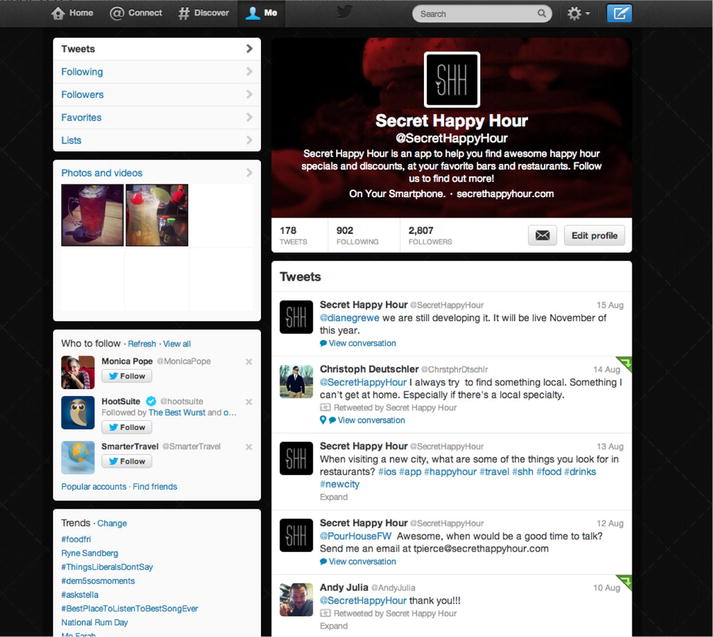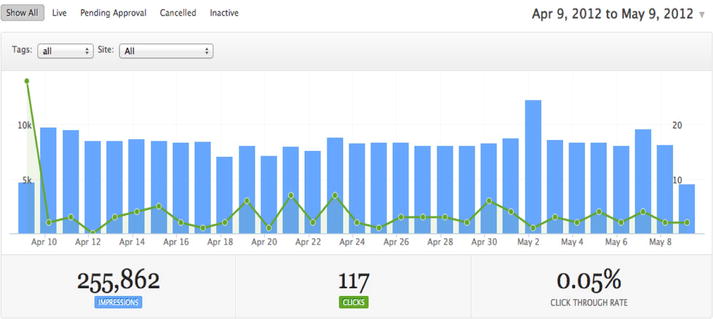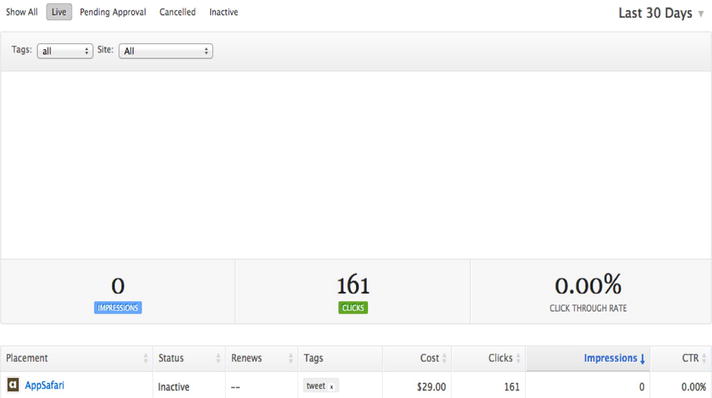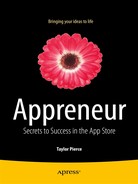Making the Most of Your Advertising Money
Experience has been my teacher concerning advertising of apps. I wish I could say that I nailed it on my first try, or second, or even third. Thankfully, I learn from my mistakes, because I made every advertising mistake one could before I became adept at using advertising effectively. One seemingly sound source of advertisement advice is ad agencies. They will likely contact you, pitching ad campaigns that are too good to be true. I fell for this a few times. I ran a massive campaign with one of these agencies and saw no increase in sales. I wasted thousands of dollars; I can tell you that something like that leaves a really bad taste in your mouth. After hearing over the years from all the fellow developers and appreneurs who have made the same mistakes, I am a little less embarrassed. By reading this book, I hope you can profit from our blunders and not have to go down the same path;I hope you can gain insight from my experiences and run successful advertising for your app on the first try!
Before we discuss what works for advertising, I want to tell you about the failures that I, along with other appreneurs, have had. One of the campaigns I quickly learned doesn’t work for the app market is Facebook sidebar ads. These are very inexpensive ads, but the truth is, no one clicks them. I imagine most people just tune them out. Morever, because the majority of Facebook users use the mobile app, which doesn’t serve any ads, app advertisement is missed by the largest segment of Facebook’s audience. Recently, however, Facebook has started showing suggested apps on its mobile app. This is where you want to advertise your app, not as a sidebar on the web site. I have yet to meet a developer who has had success with the Facebook sidebar ad model, and I highly doubt I ever will. Another issue with cost-per-click ads and apps is that when a user clicks your app’s ad—and remember, this can only happen from the desktop version of the site—that person will likely be directed to your app’s web site or App Store URL. Then, the user must grab his or her phone and search for the app name to download. I can assure you, this rarely happens. This business model works well with web sites whose goal is to gain more traffic but is just horrible for apps. If you use an impression model with Facebook, you will be dealing with the same problems. Unless your app’s ad literally screams at users, they will probably never see it. If they do click it, we are back at where we started, facing the issues discussed here.
What I do recommend for social networks is to use them to interact with your users and talk about your app. Take my app Secret Happy Hour . We started building the Twitter, Facebook, and Instagram pages months before the app was even out. Why would I do this? The answer is simple: I am making a nice little teaser for the app, and I now have a few thousand people ready to download the app the day it goes live. The key to building followers quickly is to focus on posting quality content and engaging with your users. Don’t just make your social page a huge billboard for your app; people will get tired of that. Ask your followers questions, mention features you are implementing, and request input; make users feel involved. Be certain your page reflects your app’s design look and feel so that you can really brand the entire app. The Twitter for Secret Happy Hour is a perfect example of how to do this. In only a few months we gathered a few thousand followers and have more and more people asking about the app each day.

Building followers for your app on social networks isn’t as hard as one might think. Most important, you need to make sure you are targeting your specific demographic; there is no point in gathering tons of followers who will never download your app. Let’s look at how I handled social networks for our app Secret Happy Hour. Secret Happy Hour is an app that allows users to get discounts at their favorite bars and restaurants. The discounts are served as happy hours that are available only to app users. The demographic here is people who like to go out to eat and drink, specifically people who want to get discounts while doing so. I quickly began following a lot of the hot bars and restaurants around the United States. Then, I started to follow and “favorite” users, based on specific hashtags. Hashtags are used on Twitter, Facebook, and Instagram to tag a work that users can search. I would follow and favorite users who frequenly hashtag “happyhour,” “drinks,” “food,” “discounts,” and “coupons.” Next, I began posting once every few days about what the app will do. Keep in mind that this is months before the app was released. I would then ask users what kinds of features they would like to see. To fill in the gaps between these posts, I posted interesting articles and stories about happy hours and restaurants. When you post or tweet, be sure to use the hashtags you are targeting in your post. By so doing, we were able to get approximately 2,000 followers in a month.
Recall the discussion in Chapter 4 of integration of social networks within apps. hashtag This is the most effective method of advertising on Facebook; best of all, it is free and works on mobile devices. I am a big fan of free advertising, as you will soon learn, and have found ways to market apps without spending a fortune.
The next advertising failure is banner ads. Granted, they are more productive than Facebook ads, yet they still will produce minimal results, and it is unlikely you will break even. I have tried advertising apps on a wide array of web sites. In one of my many failed banner ad ventures, I ran an ad on a popular app review web site, hoping to get great results. To my chagrin, even the popularity and content of the site did not increase my sales. Take a look at my numbers:
- 255,862 impressions
- 117 clicks
- 0.05 percent click-through rate

I paid almost $400 for the ad and saw no increase in sales. Obviously, banner ads were not worth the expense. This type of ad was also one recommended by a “big” ad agency. The issue with these agencies is that they are made up of salespeople. These people are not trying to make your app do better; they are trying to sell you something.
The failures would not be so easy to share if I couldn’t also share the good advertising moves I have made. This may sound a bit unconventional, but Twitter blasts are becoming a good, direct form of advertising. I ran a few of these and had some great results. Best of all, these ads are super cheap! Here are some statistics from an ad I ran at the same time as the banner ad mentioned earlier.
Now, the number of impressions is a little harder to gauge with tweets. For this, I am going to assume that all 9,000 followers saw the tweet, which isn’t the case, but just humor me.
- 9,000 impressions
- 161 clicks
- 1.8 percent click-through ratio

From an advertising standpoint, the percentage shown is a low click-through ratio. I am fairly sure not all the followers saw the tweet. I did, however, see approximately 80 more downloads that day. At a mere cost of $30, the tweet was a beneficial advertising choice. The Twitter ad was considerably cheaper than Facebook ads or banner ads and yielded far superior results. These packages can be found on various advertising web sites or can be purchased directly through the Twitter holder’s account.
Targeted tweets/Facebook blasts are especially useful advertising tools with specialty apps. If you have a niche app (see Chapter 1), focusing on its market population will allow for more effective advertising. I would stay away from the mass tweets mentioned earlier and try to enlist a niche celebrity to create the tweets. This may cost more, but you will see substantially better results. With this method your market is targeted; the majority of the people that follow your niche celebrity belong to the same niche population your app targets. Is the power of niche apps beginning to sink in? By working directly with popular people in your niche, you will be able to work out new and innovative approaches to advertising that can help your app sales reach their full potential.
The Power of YouTube
YouTube is a very influential form of advertising that many appreneurs simply refuse to use. I am not talking about the ads before a video or the ads that appear in the corner of the screen; instead, I propose using videos as ads. The more video ads you have, the better. I have yet to see a video on YouTube with zero views. In fact, I cannot find a video, as I am writing this, with fewer than 500 views. Because I love free advertising, I find it wasteful not to capitalize on the free YouTube advertising market. If you do not have one, create a YouTube account. Create an account for your app, your development studio, even your cat; it doesn’t matter. YouTube lets you have as many accounts as you want. If you choose to make multiple videos of your app, be sure to use a different title and different keywords for each video. You don’t want to appear to be someone who is just spamming YouTube with videos. Change them up a bit, and you will be fine. Next, contact a few of the big YouTube app review channels. CrazyMikesApps, UniqueApps, AppStoreReviewer, TechTechManTV, Appolicious, and AppVee are all good ones to reach out to. They will likely take a while to get back to you, but if they do, try to get a video review. This may cost you between $150 and $500, but it is money well spent. These channels have hundreds of thousands of subscribers, and their subscribers look up to the reviewers like gods. If they review the app favorably, their subscribers will buy it. Finally, try to enlist a few people who are popular in the niche, and have a video done (for tips on how to do this, see Chapter 1).
Although I have not had success with large advertising agencies in general, there are a few marketing firms out there that can produce successful results. These places do not come cheap, however. You aren’t paying for their time; you are paying for their contacts, and believe me, they have some good ones. One company I recently used was APPSPIRE.me (http://appspire.me ). These guys really know their business, and they have some amazing promotional contacts. What they do is make sure your app gets visibility and in the ways I have mentioned here. They will send press releases to the media, review web sites, and YouTube reviewers. They will also do Facebook and Twitter blasts for you. They specialize in advertising your app during the different life cycles, which is a huge plus; they can handle everything from prelaunch to postlaunch. If you have an app that you think has the potential to be the next big thing, I would highly recommend trying a marketing firm.
App-to-App Advertising
App-to-app advertising is a unique form of advertising that is very effective. With app-to-app advertising, you show a list of your other applications in your app. The reason this method works so well is that you have already proven the quality of your apps to the consumer. For example, let’s say a user has downloaded one of your apps; it would be reasonable to assume that if the user likes it, he or she will have no problem downloading other apps you have created. There are two styles you can use to implement this function: simple and designed. Simple is a line of code that, when tapped, directs the user to the App Store with a predefined search for your publisher name. The simple plan works well if you don’t have anyone “squatting” on your name (using the components of your publisher name as keywords in an app to gain publicity). For this reason, I like to design my own “My Apps Screen.” You can either mimic the look and feel of the App Store or create something completely different; it all boils down to how creative you can be. As with screenshot design, you should remember that creative ideas need to be executed professionally. The last thing you want is for someone not to check out your other apps because your page is poorly designed or hard to navigate. If you are ever unsure of the execution of a design choice, stick to the plain style.
Advertising Your App in Other Apps
There are basically two methods of using other apps for advertising purposes. The first option is to contact the developer of a popular app who is willing to run your app ad in his or her app. This type of arrangement will likely cost a fair sum of money, but it can achieve fantastic results. A second option is a service called Tap for Tap (www.tapfortap.com ). Tap for Tap employs a unique form of advertising. Essentially, you install the company’s SDK in your app, and it will create an ad banner for other developers’ apps in your app. Each time this is done, you earn credits; these credits allow you to advertise your app in the same manner in other developers’ apps. Using this service is an excellent way to garner exposure for your app without excessive expense.
Cross Promoting User Bases
Cross promoting user bases essentially involves using networking contacts. Through your adventures as an appreneur, you will likely meet other appreneurs who have great apps that do not compete directly with yours. You can approach these appreneurs and propose an advertising trade agreement: you can advertise to their user base and, in return, you will advertise them to yours. Again, cross promoting provides another free advertising opportunity that typically yields excellent results. I have done this a few times over the years and found it to be one of the better forms of advertising. To foster a mutually beneficial advertising relationship, you must choose the right person or app for cross promotion. I am a firm believer in the motto “It’s not what you know, it’s who you know.” Consequently, if I find an app that I like, I try to reach out to the appreneur and let that person know that I, as an appreneur, enjoyed his or her app. To me, it is the highest form of compliment when another professional within the craft expresses appreciation for your work. Generally, I’ll then proceed to talk about one of my apps or anything that might start a good conversation. By the end of the e-mail exchange, I usually have a new appreneur friend. In fact, this is how I met most of the people whose stories you have read in this book. Branch out; don’t be shy and sheltered. Most appreneurs are just like you and love meeting new people. You also have something in common: you both sell apps! No matter how much you think you know, there is always someone who knows more. Find the experts, cross promote your apps with them, and learn from them.
To maximize your app’s popularity, exhaust the recommended advertising markets: social networks (as integrated into your app, not Facebook sidebar ads), promoted tweets, and videos on YouTube. Then, wait a few days, and run a Google search for your app’s name. Because of your advertising diligence, you will probably have more results than just the standard App Store URL. This is what you want to see. The more results that appear in your search, the more web traffic your app is generating. Ideally, this data will also reflect an increase in sales, so now you can pat yourself on the back. You have just successfully advertised and marketed an app, with low risk and expense.
